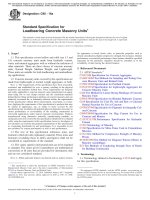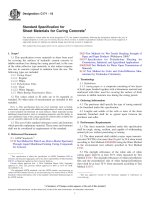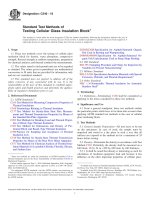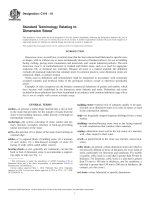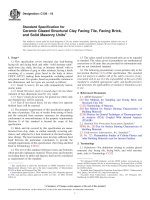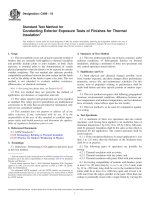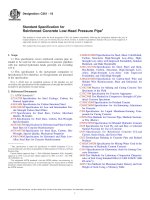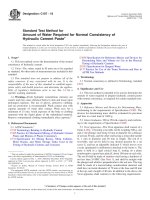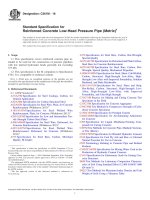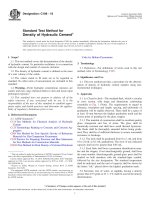Astm c 240 16
Bạn đang xem bản rút gọn của tài liệu. Xem và tải ngay bản đầy đủ của tài liệu tại đây (99.64 KB, 4 trang )
Designation: C240 − 16
Standard Test Methods of
Testing Cellular Glass Insulation Block1
This standard is issued under the fixed designation C240; the number immediately following the designation indicates the year of
original adoption or, in the case of revision, the year of last revision. A number in parentheses indicates the year of last reapproval. A
superscript epsilon (´) indicates an editorial change since the last revision or reapproval.
1. Scope
D226/D226M Specification for Asphalt-Saturated Organic
Felt Used in Roofing and Waterproofing
D4869/D4869M Specification for Asphalt-Saturated Organic Felt Underlayment Used in Steep Slope Roofing
2.2 ISO Standard:
ISO 3951 Sampling Procedure and Charts for Inspection by
Variables for Percent Nonconforming3
2.3 Military Standard:
MIL-I-24244 Specification Insulation Materials with Special
Corrosion, Chloride, and Fluoride Requirements4
2.4 Other Standard:
NRC 1.36 Nonmetallic Thermal Insulation for Austenitic
Stainless Steel5
1.1 These test methods cover the testing of cellular glass
insulation block for density, water absorption, compressive
strength, flexural strength at ambient temperature; preparation
for chemical analysis; and thermal conductivity measurements.
1.2 The values stated in inch-pound units are to be regarded
as standard. The values given in parentheses are mathematical
conversions to SI units that are provided for information only
and are not considered standard.
1.3 This standard does not purport to address all of the
safety concerns, if any, associated with its use. It is the
responsibility of the user of this standard to establish appropriate safety and health practices and determine the applicability of regulatory limitations prior to use.
3. Terminology
2. Referenced Documents
3.1 Definitions—Terminology C168 shall be considered as
applying to the terms considered in these test methods.
2.1 ASTM Standards:2
C165 Test Method for Measuring Compressive Properties of
Thermal Insulations
C168 Terminology Relating to Thermal Insulation
C177 Test Method for Steady-State Heat Flux Measurements and Thermal Transmission Properties by Means of
the Guarded-Hot-Plate Apparatus
C203 Test Methods for Breaking Load and Flexural Properties of Block-Type Thermal Insulation
C303 Test Method for Dimensions and Density of Preformed Block and Board–Type Thermal Insulation
C390 Practice for Sampling and Acceptance of Thermal
Insulation Lots
C518 Test Method for Steady-State Thermal Transmission
Properties by Means of the Heat Flow Meter Apparatus
C871 Test Methods for Chemical Analysis of Thermal Insulation Materials for Leachable Chloride, Fluoride, Silicate,
and Sodium Ions
4. Significance and Use
4.1 From a general standpoint, these test methods outline
the particular points which have to be taken into account when
applying ASTM standard test methods to the case of cellular
glass insulating block.
5. Test Methods
5.1 General Sample Preparation—All tests have to be run
on dry specimens. In case of need, the sample must be
unpacked and stored in a dry place in such a way that all
surfaces are exposed to the ambient air for a minimum of 24
hours before testing.
5.2 Density—Determine the density in accordance with Test
Method C303. Preferably, the density shall be measured on a
full block, 18 by 24 in. (450 by 600 mm) by full thickness.
5.2.1 It shall be noted that density is interesting as such for
calculation of insulated equipment load and because it has
influence on the other important properties of cellular glass.
1
These test methods are under the jurisdiction of ASTM Committee C16 on
Thermal Insulation and are the direct responsibility of Subcommittee C16.32 on
Mechanical Properties.
Current edition approved Sept. 1, 2016. Published September 2016. Originally
approved in 1950. Last previous edition approved in 2012 as C240 – 08 (2012).
DOI: 10.1520/C0240-16.
2
For referenced ASTM standards, visit the ASTM website, www.astm.org, or
contact ASTM Customer Service at For Annual Book of ASTM
Standards volume information, refer to the standard’s Document Summary page on
the ASTM website.
3
Available from American National Standards Institute (ANSI), 25 W. 43rd St.,
4th Floor, New York, NY 10036, .
4
Available from DLA Document Services, Building 4/D, 700 Robbins Ave.,
Philadelphia, PA 19111-5094, .
5
Available from Director of Regulatory Standards, US Atomic Energy
Commission, Washington, DC 20545.
Copyright © ASTM International, 100 Barr Harbor Drive, PO Box C700, West Conshohocken, PA 19428-2959. United States
1
C240 − 16
1007.6 The repeatability or single-laboratory operator precision
is 60.00060 g/cm2 or 60.030 volume % (61S). The reproducibility or multilaboratory operator precision is 60.00071
g/cm2 or 60.035 volume %. Due to a lack of a standard, no
statement is made regarding bias.
But it shall not be considered in itself as a criterion for
acceptance in the case of cellular glass.
5.3 Water Absorption:
5.3.1 Scope—This test method covers the determination of
water absorption of cellular glass insulating blocks by measuring the amount of water retained as a result of complete
immersion for a prescribed time interval. Surface blotting is
used to correct for the water absorbed on the cut surface cells.
5.3.2 Significance and Use—This test method provides a
means of measuring the water absorption of cellular glass
insulating blocks under isothermal conditions as a result of
direct immersion in liquid water. It is intended for use in
product evaluation and quality control.
5.3.3 Equipment and Materials:
5.3.3.1 Balance, minimum 1500 g capacity and 0.1 g or
greater sensitivity.
5.3.3.2 Immersion Tank, equipped with inert specimen supports and top surface weights such as stainless steel.
5.3.3.3 Synthetic Sponge, 4 by 7 by 1.5 in. (100 by 180 by
40 mm) or larger. Sponges found acceptable to use include
cellulosic sponges and fine-pored absorbent synthetic plastic
sponges.
5.3.3.4 Test Room, with temperature of 70 6 5°F (21 6
3°C) and relative humidity of 50 6 10 %.
5.3.3.5 Distilled Water.
5.3.4 Procedure:
5.3.4.1 Carefully measure the thickness, width, and length
to the nearest 1 mm of a cellular glass block, preferably 2 by
12 by 18 in. (50 by 300 by 450 mm) and calculate the volume
and exposed surface area.
5.3.4.2 Weigh the specimen to the nearest 0.1 g (W1), then
submerge it horizontally under 25 mm (1 in.) of water
maintained at 70 6 5°F (21 6 3°C). Inert top surface weights
are required to keep it submerged. After submerging it for 2 h,
set the specimen on end on a damp cotton bath towel to drain
for 10 min. After the 10 min, remove the excess surface water
by hand with a damp sponge for 1 min per large face and 1 min
for the four sides. Wring out the sponge before and once in
between for each face and pass a minimum of two times on
each surface. Blot each face of the specimen equally by
compressing the sponge by a minimum of 10 % of its thickness. Weigh the specimen immediately (W2) to the nearest 0.1
g.
5.3.5 Calculation of Results—Calculate the weight of water
absorbed (W2 − W1) and express it as a function of the exterior
surface of the sample (g/cm2). Water absorption is also be
expressed as a function of volume percent, absorbed water
volume divided by specimen volume; or as a function of
weight percent, weight of water absorbed (W2 − W1) divided
by the dry specimen weight (W1). Such ways of expressing the
results shall be strictly limited to direct comparison of results
on specimens of identical sizes.
5.3.6 Precision and Bias—The precision as determined in
inter-laboratory tests is given in Research Report RR:C16-
5.4 Compressive Strength—Determine the compressive
strength in accordance with Test Method C165 Procedure A,
with the following test parameters and specimen preparation
techniques:
5.4.1 Each of the two parallel bearing surfaces of the
specimens shall be plane. When required, rub them on a
suitable abrasive surface to produce the required flat surface.
5.4.2 The test specimens shall be 9 by 12 in. (225 by 300
mm) by nominal received thickness, 12 by 18 in. (300 by 450
mm) by nominal received thickness, or 18 by 24 in. (450 by
600 mm) by nominal received thickness. Quadrant specimens
shall be taken from any one of four equal area quadrants of the
preformed block. The minimum acceptable specimen size is 8
by 8 in. (200 by 200 mm). The report shall include the
specimen size.
5.4.3 Cap both bearing surfaces of the specimens as follows:
Coat one surface with molten Type III or Type IV asphalt
(350, +50, −25°F (preheated to 177, +28, −14°C)), completely
filling the surface cells with a small excess. Such a coating
application rate is approximately 0.20 lb/ft2 (1.0 kg/m2) 6 25
%. Immediately press the hot coated block onto a precut piece
of felt or paper laying on a flat surface. This is to prevent the
asphalt surface from sticking to the compression platten during
the test. A lightweight kraft paper is suitable, although traditionally a Type 1 roofing felt paper, commonly called a No. 15
asphalt felt, per Specification D226/D226M or D4869/
D4869M has been used.
NOTE 1—A hot asphalt capping is used to simulate field applied
systems, which require a high load bearing insulation product, ranging
from roof applications to cryogenic storage tank base applications.
Uncapped material or different cappings will give different values.
Properly capped surfaces shall be approximately plane and
parallel. Set the specimens on edge, exposing both capped
surfaces to room temperature for a minimum of 15 min to
allow the asphalt to harden before testing.
5.4.4 The number of specimens to be tested and the sampling plan shall conform to Practice C390 where applicable.
For the purpose of inspection by user’s representative or
independent third party, the number of specimens shall conform to ISO 3951 inspection level S-4, 10.0 % AQL using the
S method.
5.4.5 Compress the specimen until failure. The deformation
at failure will vary, depending on the thickness of insulation
and the thickness of the capping materials. Record the loads at
the failure point or definite yield point. The compressive
6
Supporting data have been filed at ASTM International Headquarters and may
be obtained by requesting Research Report RR:C16-1007. Contact ASTM Customer
Service at
2
C240 − 16
bars, is the use of cold-rolled steel bars. These bars generally
are sufficiently flat and uniform in thickness.
5.6.1.3 Using a third straight metal bar long enough to lap
metal bars on each side, carefully rub off the upper face of the
specimen until the scraping bar just contacts the thickness bars.
5.6.1.4 Turn the specimen upside down and place it back on
the flat metal plate and put the two metal bars on the metal
plate near two opposite sides of the specimen, this time without
the sheet of paper under each metal bar.
5.6.1.5 Repeat the rubbing operation described in 5.6.1.3.
5.6.1.6 If the specimens have to be shipped, provide adequate protection.
5.6.2 Due to the rigid nature of the material and its open cell
surface, it is preferable to have the thermocouples mounted on
the surface of the plates and not adhered to the surface of the
specimens.
5.6.3 For maximum accuracy, it is recommended that the
temperature difference between the hot and cold surfaces of the
specimens is such that the temperature gradient in the specimen
equals or exceeds 40 F/in. (900 K m−1). Avoid specimens made
from several pieces of cellular glass. Joints are prohibited in
the central measuring area and their number shall be minimized
in the guard area.
5.6.4 The number of specimens to be tested and the sampling plan shall conform to Practice C390 where applicable.
For the purpose of inspection by user’s representative or
independent third party, the number of specimens shall conform to ISO 3951 inspection level S-3, 10.0 % AQL using the
S method.
strength is calculated from this load divided by the specimen
cross sectional area in accordance with Test Method C165.
5.4.6 The rate of loading shall be determined by using
constant load rates of 250 lbf/s (1100 N/s) for 9 by 12 in. (225
by 300 mm) specimens, 500 lbf/s (2200 N/s) for 12 by 18 in.
(300 by 400 mm) specimens and 1000 lbf/s (4400 N/s) for 18
by 24 in. (450 by 600 mm) specimens. An alternate method
would be to use a crosshead speed of 0.01 in./min (0.1
mm/min) per inch (centimetre) of specimen thickness.
5.4.7 Due to the sample preparation, with the inclusion of
felts and asphalt, the method described in Test Method C165 to
determine compressive modulus of elasticity does not apply for
cellular glass as a material by itself.
NOTE 2—It has been found extremely convenient to employ a partially
submerged roll (see Fig. 1) for applying the asphalt.
5.5 Flexural Strength—Determine flexural strength in accordance with Test Method C203, Method I or Method II,
Procedure A, preferably with a test specimen 1 in. thick by 4 in.
wide by 12 in. long ( 25 mm thick by 100 mm wide by 300 mm
long).
5.5.1 Measure the distance between the supports from
center to center of the bearing bars.
5.5.2 The number of specimens to be tested and the sampling plan shall conform to Practice C390 where applicable.
For the purpose of inspection by user’s representative or
independent third party, the minimum number of specimens
shall conform to ISO 3951 inspection level S-3, 10.0 % AQL
using the S method.
5.6 Thermal Conductivity—Determine the thermal conductivity in accordance with Test Method C177 or Test Method
C518. In the case of cellular glass, the following points deserve
special attention:
5.6.1 To achieve flatness and parallelism of the surface as
required by Test Method C177 or Test Method C518, the
following method is suggested:
5.6.1.1 By sawing from the original block, prepare a specimen with the required dimensions, its thickness being 2 or 3
mm greater than the final thickness.
5.6.1.2 Place the specimen on a flat metal plate slightly
larger than the specimen itself and put two machined metal
bars on the metal plate near two opposite sides of the specimen.
Insert a uniform sheet of paper with a thickness 0.01 in. (1⁄4
mm) between the flat base plate and the metal bars but not
under the sample. The metal bars are as thick as the final
thickness of the specimen and machined so that their top and
bottom surfaces are flat and parallel. Alternatively to machined
5.7 Specimen Preparation for Chemical Analysis—When
specified in the purchase order or contract, the following
chemical analysis results shall be furnished to the purchaser.
5.7.1 Chemical Analysis for Leachable Chloride,
(Fluoride), Silicate, and Sodium Ions—Determine leachable
chloride, (fluoride), silicate and sodium ions in accordance
with Test Methods C871, MIL-I-24244, or NRC 1.36, with the
following exceptions or additions. The test specimen shall be
prepared for leaching by either of the following equivalent
methods:
5.7.1.1 Method A—Break 300 g of the sample into small
size pieces 1⁄2 in. (13 mm) or less. Comminute in a nominal
1-gal (4-L) mill one-third to one-half full of appropriate media
for 10 min. Screen out the − 200 + 325 mesh fraction of 50 g,
wash on the finer screen with 400 to 600 mL of cp methanol
using a wash bottle, and dry on the screen to constant weight
at 212 to 230°F (100 to 110°C). An appropriate grinding media
is flint pebbles or alumina pebbles.
5.7.1.2 Method B—Break 150 g of the sample into small
size pieces 1⁄2 in. (13 mm) or less. Comminute using either a
manual or motorized mortar and pestle or a blender, and
concurrently screen out the − 200 + 325 mesh fraction until 50
g is accumulated. Wash the fraction on the finer screen with
400 to 600 mL of cp methanol, using a wash bottle, and dry on
the screen to constant weight at 212 to 230°F (100 to 110°C).
5.7.1.3 Alternatively, the sized fraction will be washed in a
specially made small screen by dunking repeatedly into a
container of methanol. In any case, the screens shall be washed
first with methanol.
FIG. 1 Application of Hot Asphalt to Specimen Surfaces
3
C240 − 16
5.7.2 All of the other chemical requirements of Test Methods C871, MIL-I-24244, and NRC 1.36 are to be followed.
6.1.4 Chemical analysis results, if required, as specified in
purchase order.
6. Report
7. Keywords
6.1 The report shall include the following information:
6.1.1 Density, flexural strength and thermal conductivity
shall be reported as designated in the appropriate method.
6.1.2 Water absorption, in g/cm2.
6.1.3 Compressive strength in accordance with Test Method
C165, except that the dimensions of the test specimens shall
also be recorded.
7.1 breaking load; breaking strength; cellular materials;
compressive strength; flexural strength; thermal insulating
materials-glass; water absorption
ASTM International takes no position respecting the validity of any patent rights asserted in connection with any item mentioned
in this standard. Users of this standard are expressly advised that determination of the validity of any such patent rights, and the risk
of infringement of such rights, are entirely their own responsibility.
This standard is subject to revision at any time by the responsible technical committee and must be reviewed every five years and
if not revised, either reapproved or withdrawn. Your comments are invited either for revision of this standard or for additional standards
and should be addressed to ASTM International Headquarters. Your comments will receive careful consideration at a meeting of the
responsible technical committee, which you may attend. If you feel that your comments have not received a fair hearing you should
make your views known to the ASTM Committee on Standards, at the address shown below.
This standard is copyrighted by ASTM International, 100 Barr Harbor Drive, PO Box C700, West Conshohocken, PA 19428-2959,
United States. Individual reprints (single or multiple copies) of this standard may be obtained by contacting ASTM at the above
address or at 610-832-9585 (phone), 610-832-9555 (fax), or (e-mail); or through the ASTM website
(www.astm.org). Permission rights to photocopy the standard may also be secured from the Copyright Clearance Center, 222
Rosewood Drive, Danvers, MA 01923, Tel: (978) 646-2600; />
4
